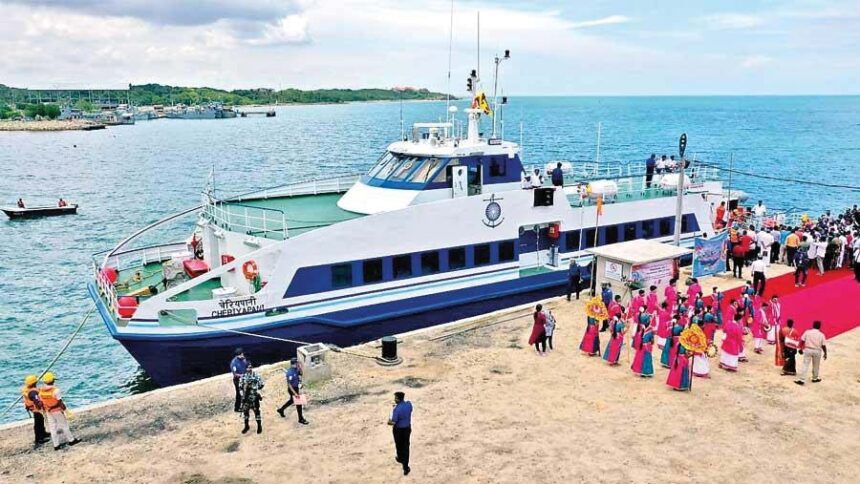Four decades after civil war disruptions severed the vital maritime link between India and Sri Lanka, ferry services have triumphantly resumed as of October 14th. This significant event has been celebrated by Indian Prime Minister Narendra Modi and Sri Lankan President Ranil Wickremesinghe, who see it as a pivotal step towards strengthening bilateral ties, enhancing connectivity, promoting trade, and revitalizing cultural links between the two nations.

The renewed ferry service connecting Tamil Nadu’s Nagapattinam and Kankesanthurai in Jaffna, Srilanka, aims to rekindle the age-old maritime connections that have historically existed between these neighbouring countries.
The newly launched high-speed ferry, named ‘Cheriyapani,’ is operated by the Shipping Corporation of India (SCI) and boasts a capacity of 150 passengers. Covering a distance of approximately 60 nautical miles (110 kilometres) between Nagapattinam and Kankesanthurai, the journey takes about 3.5 hours, depending on sea conditions.
During its inaugural voyage, the ‘Cheriyapani’ ferry carried 50 passengers from India to Sri Lanka and returned with 38 passengers in the evening. These passengers expressed joy at the opportunity to sail to Sri Lanka and experience this historic moment.
Indian Prime Minister Narendra Modi emphasized the significance of the ferry service, stating that it not only brings the two cities closer but also fosters closer ties between the people and hearts of India and Sri Lanka. He described this as the beginning a new chapter in diplomatic and economic relations between the two countries.
Modi underlined the shared history of culture, commerce, and civilization between India and Sri Lanka, pointing out that Nagapattinam and nearby towns have been renowned for sea trade with various countries, including Sri Lanka. He also noted the historical importance of the port of Poompuhar, which is mentioned as a hub in ancient Tamil literature.
Additionally, Modi mentioned the literary works of the Sangam age, such as ‘Pattinappalai’ and ‘Manimekalai’, which describe the movement of boats and ships between the two countries. He invoked the great poet Subramania Bharti’s song ‘Sindhu Nadhiyin Misai,’ which mentions a bridge connecting India and Sri Lanka and highlights how the ferry service rekindles these historical and cultural connections.
Sri Lankan President Ranil Wickremesinghe expressed his enthusiasm, stating that the ferry service is crucial in enhancing connectivity between the two nations. He reflected on the historical significance of people traversing the Palk Strait for thousands of years, contributing to developing their cultures and trade. Wickremesinghe credited the return of peace as the catalyst for re-establishing this sea connectivity. He thanked Prime Minister Modi and the Indian Shipping Corporation for making it a reality.

Indian External Affairs Minister S. Jaishankar hailed this milestone as a “big step for people-to-people contacts between India and Sri Lanka.”
This initiative seeks to revive historical maritime connections from the early 1900s when the Indo-Ceylon Express, a train service between Chennai and Colombo via Thoothukudi, ceased operations in 1982 due to the civil war in Sri Lanka.
The resumption of ferry services marks a significant step towards rekindling historical ties and forging stronger relations between India and Sri Lanka in the modern era. As the ferry ‘Cheriyapani plies the waters of the Palk Strait, it carries with it the hope of a brighter future and the rekindling of cultural and economic exchanges between these two South Asian neighbours.
The historical link between Nagapattinam and Kankesanthurai dates back approximately 3000 years to ancient times when both regions flourished as bustling maritime trade hubs. Historical records show these coastal towns were pivotal in facilitating trade between India and Sri Lanka. They were vital conduits for exchanging goods such as spices, textiles, gemstones, and other valuable commodities.
Sangam literature, which dates back over two thousand years, references maritime trade and voyages between India and Sri Lanka. Works such as the ‘Pattinappalai’ and ‘Manimekalai’ describe these regions’ active trade and cultural ties. “Pattinappalai” represents the beauty and prosperity of ancient Tamil port cities, including Poompuhar. In this Sangam work, Poompuhar is celebrated for its maritime trade, bustling port activities, and its role as a significant trading centre during the Sangam period.
Archaeological excavations in and around Nagapattinam have uncovered relics, pottery, and artefacts that indicate direct evidence specific to the Nagapattinam-Kankesanthurai ferry route’s history of maritime trade and interactions. These discoveries corroborate the historical significance of the region’s maritime connections.



